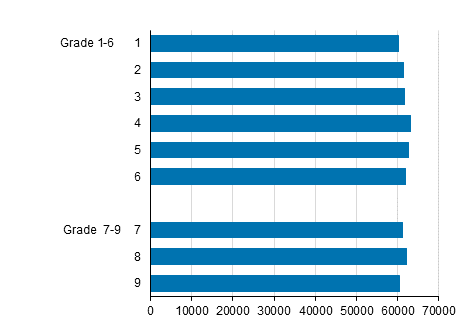Published: 31 March 2021
Comprehensive schools had 566,600 pupils in 2020
According to Statistics Finland’s education statistics, comprehensive schools had 566,600 pupils in 2020. The number of pupils in comprehensive schools grew by 0.4 per cent from the year before. Forty-nine per cent of the pupils were girls and 51 per cent were boys. A total of 371,400 pupils attended grades 1 to 6 of comprehensive schools and 183,900 pupils grades 7 to 9.
Comprehensive school pupils in grades 1 to 9 in 2020

A total of 1,000 pupils attended additional education (grade 10), of whom 500 in comprehensive schools. The number of pupils attending comprehensive schools also includes pre-primary education pupils in connection with basic education, numbering 10,800. More information can be found in the quality description of this set of statistics.
In autumn 2020, a total of 501 pupils were being home-schooled. There were 327 pupils temporarily residing abroad. Time series data on students not studying in comprehensive schools can be found in the appendix table of this publication.
A total of 5,400 students were studying in basic education of adults. Of them, 51 per cent were men. Until 2019, data on basic education of adults have been published in the statistics on adult education of educational institutions .
Data on the development of the number of comprehensive schools can be found in the statistics on providers of education and educational institutions .
Source: Education. Statistics Finland
Inquiries: Vesa Hämäläinen 029 551 2594, Anna Loukkola 029 551 3678, koulutustilastot@stat.fi
Head of Department in charge: Hannele Orjala
Publication in pdf-format (196.9 kB)
- Tables
-
Tables in databases
Pick the data you need into tables, view the data as graphs, or download the data for your use.
Appendix tables
Updated 31.3.2021
Official Statistics of Finland (OSF):
Students and qualifications [e-publication].
ISSN=2737-0410. Pre-primary and basic education 2020. Helsinki: Statistics Finland [referred: 10.12.2025].
Access method: http://stat.fi/til/opiskt/2020/13/opiskt_2020_13_2021-03-31_tie_001_en.html

